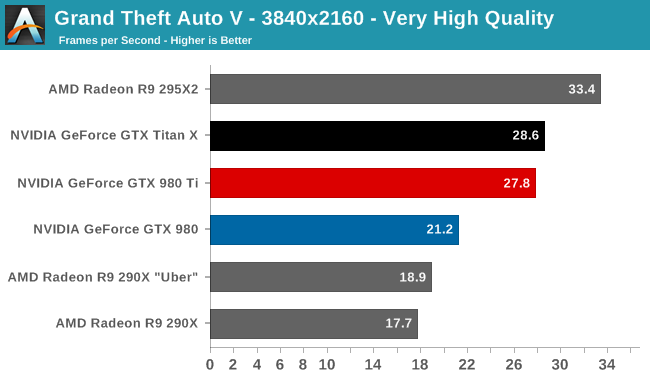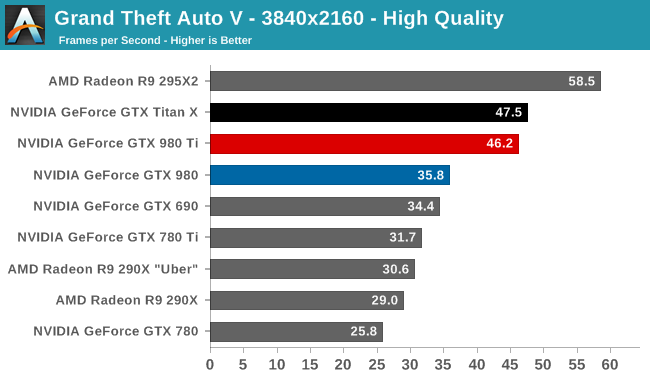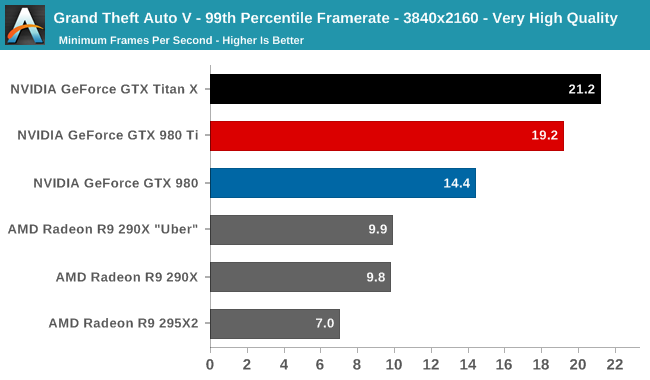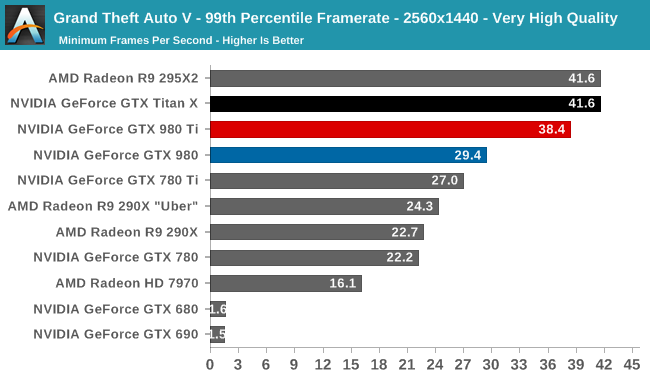The NVIDIA GeForce GTX 980 Ti Review
by Ryan Smith on May 31, 2015 6:00 PM ESTGrand Theft Auto V
The final game in our review of the GTX 980 Ti is our most recent addition, Grand Theft Auto V. The latest edition of Rockstar’s venerable series of open world action games, Grand Theft Auto V was originally released to the last-gen consoles back in 2013. However thanks to a rather significant facelift for the current-gen consoles and PCs, along with the ability to greatly turn up rendering distances and add other features like MSAA and more realistic shadows, the end result is a game that is still among the most stressful of our benchmarks when all of its features are turned up. Furthermore, in a move rather uncharacteristic of most open world action games, Grand Theft Auto also includes a very comprehensive benchmark mode, giving us a great chance to look into the performance of an open world action game.
On a quick note about settings, as Grand Theft Auto V doesn't have pre-defined settings tiers, I want to quickly note what settings we're using. For "Very High" quality we have all of the primary graphics settings turned up to their highest setting, with the exception of grass, which is at its own very high setting. Meanwhile 4x MSAA is enabled for direct views and reflections. This setting also involves turning on some of the advanced redering features - the game's long shadows, high resolution shadows, and high definition flight streaming - but it not increasing the view distance any further.
Otherwise for "High" quality we take the same basic settings but turn off all MSAA, which significantly reduces the GPU rendering and VRAM requirements.



After initially expecting Grand Theft Auto to be a walk in the park performance wise, the PC version of the game has instead turned out to be a very demanding games for our GPUs. Even at 1440p we can’t have very high quality with MSAA and still crack 60fps, though we can get very close.
Ultimately GTA doesn’t do any better than any other game in setting apart our GM200 cards. GTX 980 Ti trails GTX Titan by 4% or less, essentially the average outcome at this point. Also average is the GTX 980 Ti’s lead over the GTX 980, with the newest card beating the older GTX 980 by 29-31% across our three settings. Finally, against the GTX 780 the GTX 980 Ti has another strong showing, with a 69-79% lead.
On an absolute basis we can see that at 4K we can’t have 4x MSAA and even crack 30fps on a single-GPU card, with GTX 980 Ti topping out at 27.8 fps. Taking out MSAA brings us up to 46.2fps, which is still well off 60fps, but also well over the 30fps cap that this game was originally designed against on the last-generation consoles.



Along with an all-around solid benchmark scene, the other interesting benchmarking feature of GTA is that it also generates frame percentiles on its own, allowing us to see the percentiles without going back and recording the game with FRAPS. Taking a look at the 99th percentile in this case, what we find is that at each setting GTA crushes some group of cards due to a lack of VRAM.
At 4K very high quality, 4GB cards have just enough VRAM to stay alive, with the multi-GPU R9 295X2 getting crushed due to the additional VRAM requirements of AFR pushing it over the edge. Not plotted here are the 3GB cards, which saw their framerates plummet to the low single-digits, essentially struggling to complete this benchmark. Meanwhile 1440p at high quality crushes our 2GB cards, with less VRAM than a Radeon HD 7970 falling off of the cliff.
As for what this means for the GTX 980 Ti, the situation finds the GTX 980 Ti trailing the GTX Titan X in 99th percentile framerates by anywhere between 3% and 10%. This test is not designed to push more than 6GB of VRAM, so I’m not entirely convinced this isn’t a wider than normal variance (especially at the low framerates for 4K), though the significant and rapid asset streaming this benchmark requires may be taking its toll on the GTX 980 Ti, which has less VRAM for additional caching.










290 Comments
View All Comments
xenol - Monday, June 1, 2015 - link
Transistor count means nothing. The GTX 780 Ti has 2.8 billion transistors. The GTX 980 has around 2 billion transistors, and yet the GTX 980 can dance with the GTX 780 Ti in performance.As the saying goes... it's not the size that matters, only how you use it.
Niabureth - Monday, June 1, 2015 - link
Don't want to sound like a messer schmitt but thats 2,8K cuda cores for GK110, and 2K for the GM204. The GK110 has 7.1 billion transistors.jman9295 - Tuesday, June 2, 2015 - link
In this very article they list the transistor count of those two cards in a giant graph. The 980 has 5.2 billion transistors and the 780ti 7.1 billion. Still, your point is the same, they got more performance out of less transistors on the same manufacturing node. All 28nm means is how small the gap is between identical components, in this case the CUDA cores. Each Maxwell CUDA is clearly more efficient than each Kepler. Also helping is the double VRAM size which probably allowed them to also double the ROP count which greatly improved transistor efficiency and performance.Mithan - Sunday, May 31, 2015 - link
It matters because we are close to .16/20nm GPU's, which will destroy these.dragonsqrrl - Sunday, May 31, 2015 - link
"we are close to .16/20nm GPU's"People said the same thing when the 750Ti launched. I'll give give you one thing, we are closer than we were, but we are not "close".
Kevin G - Monday, June 1, 2015 - link
The difference now is that there are actually 20 nm products on the market today, just none of them are GPUs. It seems that without FinFET, 20 nm looks to be optimal only for mobile.felicityc - Tuesday, January 11, 2022 - link
What if I told you we are on 8nm now?LemmingOverlord - Monday, June 1, 2015 - link
@SirMaster - The reason people care about the process node is because that right now - in mid-2015 - this is an extremely mature (ie: old but well-rehearsed) manufacturing process, which has gone through several iterations and can now yield much better results (literally) than the original 28nm process. This means that it's much cheaper to produce because there are less defective parts per wafer (ie: higher yield). Hence ComputerGuy2006 saying what he said.Contrary to what other people say "smaller nm" does NOT imply higher performance. Basically when a shrink comes along you can expect manufacturers to do 1 of two things:
a) higher transistor count in a similar die size, with similar power characteristics when compared to its ancestor - and therefore higher performance
b) same transistor count in a much smaller die size, therefore better thermals/power characteristics
Neither of these factor in architectural enhancements (which sometimes are not that transparent, due to their immaturity).
So ComputerGuy2006 is absolutely right. Nvidia will make a killing on a very mature process which costs them a below-average amount of money to manufacture.
In this case Nvidia is using "defective" Titan X chips to manufacture 980 Ti. Simple as that. Their Titan X leftovers sell for $350 less and you still get almost all the performance a Titan would give you.
royalcrown - Wednesday, June 3, 2015 - link
I take issue with point b) " same transistor count in a much smaller die size, therefore better thermals/power characteristics"I disagree because the same die shrink can also cause a rise in power density, therefore WORSE characteristics (especially thermals).
Gasaraki88 - Monday, June 1, 2015 - link
Smaller nm, bigger e-peen.